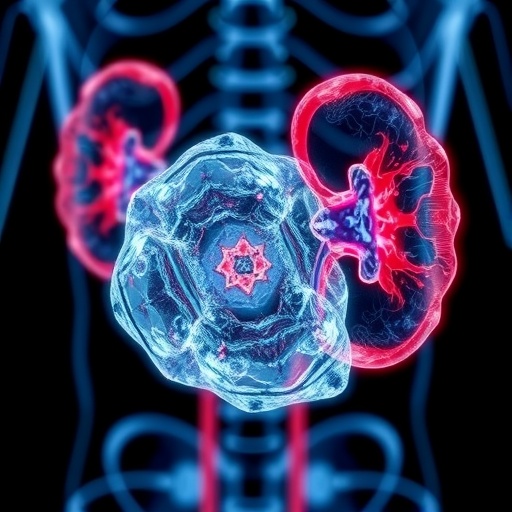In the realm of urological surgery, laser lithotripsy has established itself as a paramount technique for breaking down kidney stones. This procedure utilizes a small, video-guided laser that targets stones within the kidney, pulverizing them into tiny fragments that can be more easily removed or naturally excreted. However, optimizing the efficiency of this laser treatment has posed challenges: powerful lasers, while effective in breaking stones into finer dust, often generate excessive heat. Such thermal stress risks damaging the surrounding kidney tissue, potentially exacerbating patient recovery times and postoperative complications.
Researchers at the University of Chicago Pritzker School of Molecular Engineering (UChicago PME), under the leadership of Assistant Professor Po-Chun Hsu, in close collaboration with Duke University’s engineering and medical teams, have unveiled a novel approach that boosts the efficacy of laser lithotripsy without necessitating modifications to the current laser technologies. Their breakthrough hinges on innovatively engineering the environment around the stone—specifically, the saline solution used during the procedure—to improve laser energy absorption and precision. Their findings, published in the journal Advanced Science, herald potential paradigm shifts in kidney stone management, promising reduced surgical durations, expedited recovery phases, and decline in recurrence rates.
Laser lithotripsy predominantly relies on holmium:yttrium-aluminum-garnet (Ho-YAG) lasers, which currently represent the gold standard in stone ablation. These lasers emit infrared light around a wavelength of 2,000 nanometers, tailored to target calcified kidney stones. In the surgical setting, a mild saline solution irrigates the affected kidney area to distend the hollow spaces and sustain visibility. However, a significant portion of the laser’s energy disperses into this fluid, manifesting as unwanted heat dissipation and diminishing the effective energy transferred to the kidney stone itself.
The interdisciplinary team addressed this inefficiency by introducing nanoparticles into the saline—ingeniously designed nanomaterials capable of absorbing the laser’s specific wavelengths. Embedded within the fluid, these conducting polymer nanoparticles act as laser energy concentrators, minimizing reflective loss and energy diffusion. As a result, a substantially higher fraction of the laser’s power is directly harnessed to fragment the stone. This innovation not only enhances ablation efficiency but also mitigates the collateral thermal damage to renal tissue, preserving patient safety.
From a materials science perspective, selecting the appropriate nanoparticle characteristics was crucial. The particles needed to possess strong absorption properties matching the laser wavelength, excellent dispersibility in aqueous solutions, and, importantly, biocompatibility to ensure patient safety. The research team meticulously engineered the nanofluid, confirming through in vitro studies that their formula met these criteria. Toxicity assays demonstrated that even after prolonged exposure—far exceeding the typical timeframe of lithotripsy—living cells remained unharmed by the nanoparticle-infused saline, underscoring its clinical potential.
Quantitative results from laboratory experiments were particularly striking. The nanofluid-enhanced lithotripsy exhibited improvements in stone ablation efficiency ranging from 38% to an astounding 727% during spot-targeted treatment, and between 26% to 75% in scanning approaches. These enhancements could dramatically shorten intervention times; a procedure currently lasting approximately 30 minutes might be condensed to as little as 10 minutes. Such reductions not only minimize anesthesia exposure but also substantially decrease the accumulation of thermal energy in renal tissues, further safeguarding against heat-induced injury.
A notable aspect of this research is its versatility across different laser types. While this study specifically examined Ho-YAG lasers, other laser technologies employed in lithotripsy vary in wavelength and operational characteristics. Dr. Pei Zhong of Duke University, one of the study’s senior authors, emphasizes that nanofluid therapy holds promise to augment a wide range of lithotripsy lasers. Its capacity to enhance performance irrespective of stone composition or laser wavelength could democratize access, enabling community hospitals to achieve superior outcomes without investing in multiple costly laser systems.
Beyond engineering ingenuity, this collaboration exemplifies the profound impact of interdisciplinary research. Clinicians at Duke Health collaborated intimately with engineers specializing in nanomaterials and laser physics, fostering a fertile exchange of ideas. As Michael Lipkin, a Duke urologist and co-author, reflects, such partnerships are instrumental in translating fundamental scientific insights into practical medical innovations that directly benefit patients.
Looking ahead, the research team is poised to expand on their promising initial findings with further studies. These will assess how the nanofluid-enhanced approach performs against naturally occurring kidney stones of varying compositions, as well as its efficacy with other established laser systems. These forthcoming investigations will be pivotal in moving from preclinical validation toward widespread clinical adoption.
This breakthrough not only exemplifies a significant scientific achievement but also addresses a pressing healthcare burden. Kidney stone disease afflicts approximately 11% of the American population, contributing to substantial clinical workload and immense healthcare expenditure exceeding $2 billion annually in the United States alone. Technological advancements that enhance the safety, speed, and effectiveness of lithotripsy have profound implications for improving patient quality of life and reducing systemic costs.
In sum, this pioneering nanofluid technology represents an elegant solution whereby modifying the laser’s working environment—rather than the laser device itself—unlocks superior treatment outcomes. As this field evolves, the integration of materials science, engineering, and clinical medicine continues to demonstrate transformative potential in urology and beyond, exemplifying the power of scientific innovation in addressing complex medical challenges.
Subject of Research: Nanomaterial-enhanced laser lithotripsy for improved kidney stone ablation efficiency.
Article Title: Nanofluid-Enhanced Laser Lithotripsy Using Conducting Polymer Nanoparticles
News Publication Date: October 5, 2025
Web References:
https://advanced.onlinelibrary.wiley.com/doi/10.1002/advs.202507714
References:
Fan et al., “Nanofluid-Enhanced Laser Lithotripsy Using Conducting Polymer Nanoparticles,” Advanced Science, 2025.
Image Credits: UChicago Pritzker School of Molecular Engineering / John Zich
Keywords: Nanomaterials, Surgical procedures, Laser lithotripsy, Kidney stones, Nanofluid, Biocompatible nanoparticles, Ho-YAG laser, Thermal protection, Medical innovation




